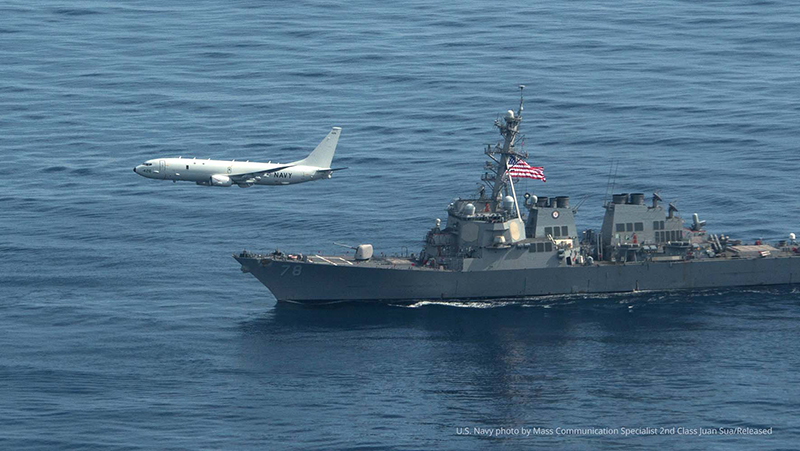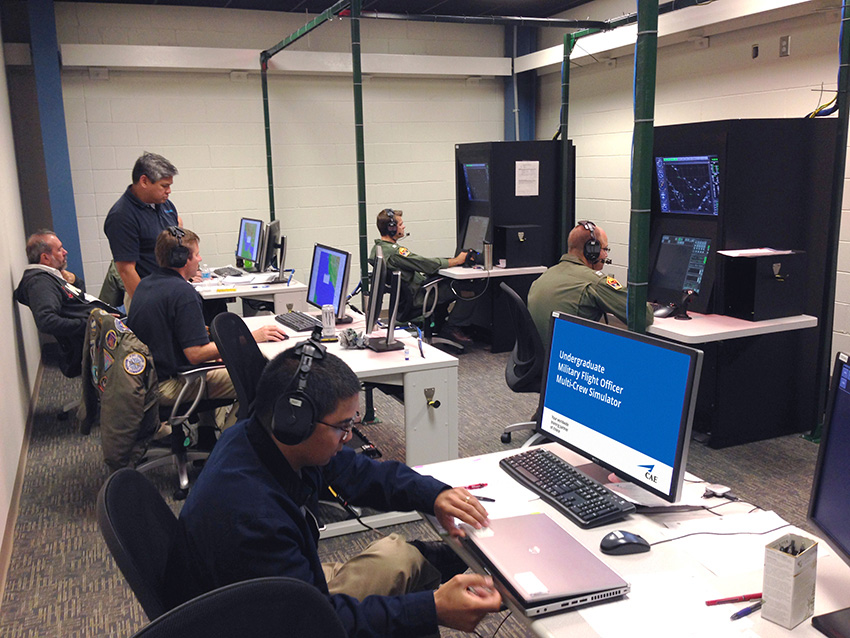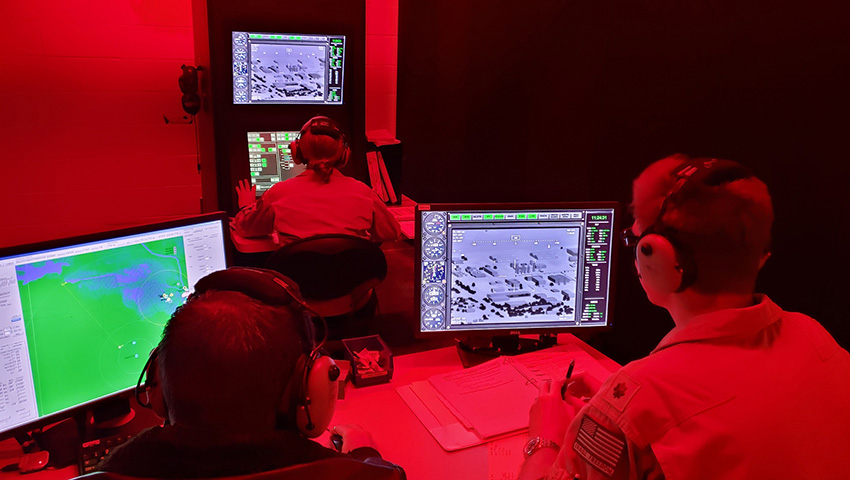With more fifth-generation multi-mission aircraft entering service worldwide, it is vital that crews are trained to the highest possible standards so that they can effectively carry out their highly complex mission sets.
While flying an aircraft is of clear importance to overall mission effectiveness, there are advanced operations that mission crew are responsible for that deliver the desired combat capability. These tasks performed by mission crew include electronic warfare, maritime patrol, airborne early warning, navigation, command and control, and weapons and sensor management.
Individual militaries label mission crews differently. Whether they are called air battle managers or air warfare officers in Australia, or Naval Flight Officers (NFOs) in the case of the United States Navy (USN), these critical operators are responsible for a variety of sensors, systems, and weapons from the rear of an aircraft such as the P‑8A Poseidon.
Initial U.S. Navy NFO training is carried out under the Maritime Command & Control (MC2) training program run out of Naval Air Station (NAS) Pensacola. Affectionately known as the “Cradle of Naval Aviation”, NAS Pensacola is the initial primary training base for all U.S. Navy, Marine Corps and Coast Guard officers pursuing designation as naval aviators and NFOs. CAE has been supporting the delivery of NFO training with instructors and state-of-the-art simulation systems for nearly a decade.
“We have a wealth of experience delivering transformative, integrated training,” says Scott “Homer” Laedlein, CAE USA’s site manager at NAS Pensacola supporting the NFO training for the Chief of Naval Air Training (CNATRA). “Our experience with the Navy has taught us how to best deliver a comprehensive mission crew training system that ensures students are qualified and ready to advance to their operational fleet assignment.”
 CAE is an experienced provider of training systems and services for mission crew, such as training support for U.S. Navy Naval Flight Officers before advancing to aircraft such as the P-8A Poseidon.
CAE is an experienced provider of training systems and services for mission crew, such as training support for U.S. Navy Naval Flight Officers before advancing to aircraft such as the P-8A Poseidon.
USN NFO training
A big part of NFO training is delivered in what is called the Naval Flight Officer Training System Multi-Crew Simulator (NFOTS MCS), which was designed and developed by CAE. Upon arriving at NAS Pensacola, students receive basic aviation training, after which the soon-to-be Naval Flight Officer transfers to VT-10, the primary flight training squadron. There they will learn basic aviation and airspace skillsets, and it is then determined whether they transition to the strike fighter pipeline to operate aircraft such as the F/A-18 Super Hornet, or onto the Navy’s fleet of multi-mission aircraft such as the P-8A, E-6B, or E-2D.
Those trainees who will advance to multi-mission aircraft will then transition to VT-4, the Navy’s first simulator-only training squadron, where they will train on the CAE-built Multi-Crew Simulator (MCS), a flexible system that supports training for a wide range of mission crew tasks.
The MCS provides students with a core understanding of how a variety of airframes operate and introduces students to a range of missions performed by NFOs. From there, the Navy selects students for advanced training on one of the Navy’s multi-mission aircraft, including the E-2D airborne early warning aircraft; the P-8A Poseidon maritime patrol aircraft; the E-6B Mercury airborne command and control and strategic communications platform; or the EP-3 electronic signals aircraft. Training then continues on the MCS tailored to the respective aircraft mission profiles.
Students are not only introduced to the operation of the respective functions of each aircraft type, but they are also exposed to operational areas where they will typically operate. “The Multi-Crew Simulator introduces a high fidelity virtual environment to train student Naval Flight Officers specifically on the platforms that they will actually operate once they enter the fleet,” said Michael “Tiki” Varias, CAE’s instructor and assistant site manager for the Maritime Command & Control training program at NAS Pensacola.
“What’s interesting about this simulator is the capability to simulate specific operational areas in a virtual training environment,” continued Varias. “These environments include the Pacific Command and Central Command, and the Multi-Crew Simulator offers entry-level Naval Flight Officers early exposure to those areas before they even see it in the real world when they join the fleet.”
The Multi-Crew Simulator is a USN-specific version of CAE’s Tactical Mission Trainer (TMT), a modular, adaptive, reconfigurable training platform that supports both simulated training as well as in-aircraft training.
CAE’s TMT also forms the basis of Royal Navy Observer training and the Royal Canadian Air Force’s (RCAF) in-aircraft training of Air Combat Systems Officers and Airborne Sensor Operators.
A transformative training system
So, what makes this capability so appealing to these users? CAE’s MCS/TMT is able to help produce more qualified, combat-ready mission crew much faster than was previously possible, and in a more efficient and less expensive way.
Before the MCS rollout for the USN, students would go through primary training to get the basics of aviation and airspace utilization and were then sent to a fleet replacement squadron where they would learn the tactics and the performance of operational aircraft. Now, this training is introduced much earlier in the NFO training syllabus because of the flexibility and fidelity of the MCS.
“Our objective is to produce combat-quality Naval Flight Officers,” said Capt. Ken Russell, Commodore, Training Air Wing 6 (CTW-6) for the U.S. Navy. “The Maritime Command and Control training program, which uses the Multi-Crew Simulator extensively, has enabled us to deliver mission-oriented Naval Flight Officers to the fleet who are at a much higher standard of proficiency and readiness. The adaptability and flexibility of the training system allows us to readily expand to new type-model series and future mission sets, such as remotely piloted aircraft operations.”
CAE’s Laedlein suggests the Multi-Crew Simulator has helped streamline the NFO training pipeline and graduate NFOs are more prepared for advanced training and their operational assignments.
“When they hit the fleet, they are experienced at a level that I would say is roughly two years ahead of what those Naval Flight Officers used to be prior to the introduction of the Multi-Crew Simulator,” said Laedlein.
Not only are students more advanced in their training by the time they hit the fleet, this simulation-based training approach also means the in-aircraft training can be more advanced and focused on mission scenarios, and there is increased availability of the aircraft fleets for operational use. Though not the driving factor for the Navy, an added benefit of simulation-based training is it being far less expensive than using the actual aircraft, and time to train from start to finish is significantly reduced.
 CAE has provided the U.S. Navy with Multi-Crew Simulators and supports the delivery of training to USN Naval Flight Officers at NAS Pensacola.
CAE has provided the U.S. Navy with Multi-Crew Simulators and supports the delivery of training to USN Naval Flight Officers at NAS Pensacola.
Flexible and scalable
The proven experience of using CAE’s MCS/TMT with key NATO nations shows that this hybrid synthetic and live training approach is disrupting the way that mission crews are trained.
The scalability and flexibility of this integrated training system, combined with new digital training capabilities such as virtual reality, could be the ideal choice for other nations seeking transformative mission crew training.
CAE’s experience as a training systems integrator is well suited to the Australian Defence Force’s AIR5428 Phase 3 Aviation Mission Training System requirement, through which the Royal Australian Air Force will provide its students with mission aircrew training.
The Aviation Mission Training System will prepare students for their operational training on RAAF aircraft, including the P-8A Poseidon, E/A‑18 Growler electronic warfare aircraft, and the E‑7A Wedgetail air battlespace management platform.
CAE has already trained a sizable cadre of mission crew for the USN who have progressed to aircraft such as the P‑8A. With the flexibility and reconfigurability of CAE’s training systems, adapting to the mission crew training requirements of other aircraft types such as the Growler and Wedgetail is a low-risk endeavour.
“The ability to deliver more qualified mission crew faster and more efficiently is what the Royal Australian Air Force requires, and the CAE-led Team AUStringer in Australia is ready to develop and deliver a sovereign Aviation Mission Training System tailored specifically to the RAAF requirements,” said Matthew Sibree, Managing Director, CAE Australia Pty Ltd.


